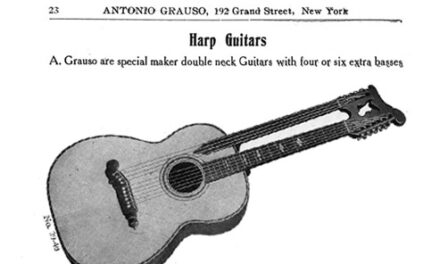…oh, the stories it could tell.
Because, while we may know very little specifically about this instrument, an attractive Mozzani chitarra lyra ad un braccio, we know that its path, and that of its owner, must have been an interesting one!

This is just a brief snapshot – via a short interview with the daughter (Orit Peleg, at right, as a toddler surrounded by her mother’s instruments in Israel) – but where there is a harp guitar, there is (presumably) a harp guitar player; and any small glimpse we have into the past – of a performer or an instrument – is always worth pursuing, don’t you agree?
Ester Goldenberg-Bromberger-Ranot was born in Russia in 1907, but a year later moved with her grandparents to Israel, where she grew up. The three hyphenated names equate to her maiden, father’s, and baptized names.
When she was 18 years old, an aunt gave her a guitar, an instrument otherwise unavailable in Israel at the time. It immediately became her one and only passion. There was a local Russian player whom she was able to take lessons from, but he quickly taught her all he knew, and Ester was soon ready for more. She needed a real teacher.
And so, following her passion, at age 20 or 21 – now in the late 1920’s – she left her native country for Europe, via ship. (The timing may have been helped by the fact that she was also running away from an ex-lover.)
She soon ended up studying guitar with Luigi Mozzani (then in Bologna). Regrettably, she would later mention little about Mozzani or this period to her children.
The timeline of this next adventure is curious. Apparently, Mozzani himself suggested she study with Segovia, the “ultimate.” So, as remembered by her children, she went to Spain “sometime in the 1930s, even though it was in the midst of their Civil war.” By all accounts, Segovia had moved to Uruguay in 1935 (to avoid the war), so perhaps this was the early ‘thirties.
By now, learning to play guitar was her one and only interest. She never held a job, nor had any money. Somehow, her passion alone apparently convinced these important players/teachers to take her on.
Segovia told her that to be a professional guitarist, one must practice 8 hours a day, which he did. Ester said she would sit by his side and absorb everything, during which time he would also instruct her.

She went back to Israel in the early 1940s. Soon after, Mozzani (who died in 1943) shipped to her a heavy box containing a gift: one of his chitarra lyras. Curiously (according to her mother), at the same time, Mozzani sent “an identical instrument” to Segovia (one of his harp guitars, not a six-string – Orit seems quite certain of this). One wonders about the relationship between Mozzani and Segovia, and the reaction of the latter upon receiving a gift in the form of a harp guitar (Segovia was ever adamantly against extra strings)!
Sadly, Ester never performed publicly – Orit is not sure why, but suspects the opportunities were just not there. Instead, she became a private teacher in schools and conservatories, and finally, by the 1960s, was giving lessons in her home. All this time, she was the only guitar teacher in Israel.
Guitar continued to be her only passion and she would often act as a promoter, inviting other guitar players to Israel to play (Orit remembered Paco Peña, as one example).
Ester passed away in 1990, leaving her instruments to her two children. Her daughter, Orit Peleg, has the Mozzani. She is now retired (from a career as a mortgage broker) and living in Mexico, near Paracho, the famous guitar-making town. She found a master luthier there to restore the Mozzani and enjoys having it as a memento of her mother’s life and passion.
Though it remains silent, it can still tell a good story.









